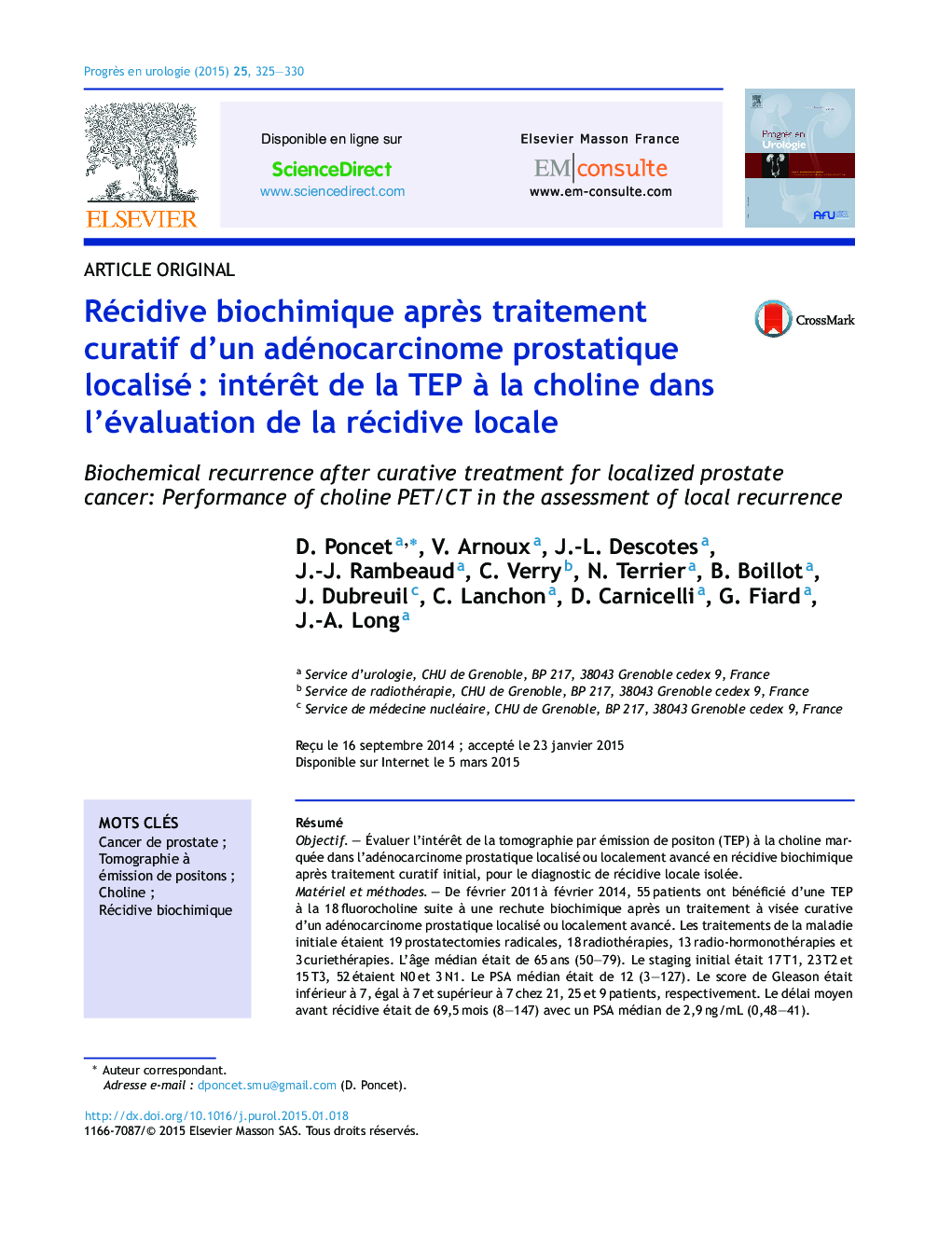| Article ID | Journal | Published Year | Pages | File Type |
|---|---|---|---|---|
| 3823899 | Progrès en Urologie | 2015 | 6 Pages |
RésuméObjectifÉvaluer l’intérêt de la tomographie par émission de positon (TEP) à la choline marquée dans l’adénocarcinome prostatique localisé ou localement avancé en récidive biochimique après traitement curatif initial, pour le diagnostic de récidive locale isolée.Matériel et méthodesDe février 2011 à février 2014, 55 patients ont bénéficié d’une TEP à la 18 fluorocholine suite à une rechute biochimique après un traitement à visée curative d’un adénocarcinome prostatique localisé ou localement avancé. Les traitements de la maladie initiale étaient 19 prostatectomies radicales, 18 radiothérapies, 13 radio-hormonothérapies et 3 curiethérapies. L’âge médian était de 65 ans (50–79). Le staging initial était 17 T1, 23 T2 et 15 T3, 52 étaient N0 et 3 N1. Le PSA médian était de 12 (3–127). Le score de Gleason était inférieur à 7, égal à 7 et supérieur à 7 chez 21, 25 et 9 patients, respectivement. Le délai moyen avant récidive était de 69,5 mois (8–147) avec un PSA médian de 2,9 ng/mL (0,48–41).RésultatsDans 42 cas, l’imagerie TEP à la choline a objectivé des foyers hyperfixants évocateurs de récidive, métastatique (6), ganglionnaire (26) et locale isolée (10). La présence d’une hyperfixation locale à la TEP a fait réaliser dans 5 cas des biopsies prostatiques confirmant la récidive histologique de l’adénocarcinome dans 4 cas. Parmi les 10 patients en récidive locale isolée, 8 ont bénéficié d’un traitement par radiothérapie de rattrapage. Parmi les 13 cas où la TEP à la choline n’a pas montré de récidive, 7 IRM multiparamétriques pelviennes ont été réalisées. L’IRM a montré une récidive locale chez 3 patients, confirmée dans 2 cas par des biopsies prostatiques.ConclusionDans notre série, en cas de récidive biochimique d’un adénocarcinome prostatique localisé ou localement avancé, la TEP choline permettait de détecter une récidive locale isolée dans près de la moitié des cas mais ne présentait pas une sensibilité suffisante pour exclure une récidive locale en cas de négativité. Elle ne se substituait pas à l’IRM ou à des biopsies prostatiques complémentaires.Niveau de preuve5.
SummaryObjectiveTo establish 18 fluorocholine-positron emission tomography/computed tomography (F-PET/CT) performances for the detection of local recurrence in a population of patients with biochemical failure after primary curative treatment for localized prostate carcinoma.Material and methodFrom February 2011 to February 2014, 55 patients underwent a F-PET/CT for biochemical relapse after primary radical therapy for prostate cancer localized or locally advanced. Primary therapies for prostate cancer were 19 radical prostatectomy, 18 radiotherapy, 13 radiotherapy with hormonal treatment, 3 brachytherapy. The median age was 65 years (50–79). The initial staging was 17 T1, 23 T2 and 15 T3, 52 were N0 and N1 3. The median PSA was 12 (3–127). The Gleason score was less than 7, equal to 7 and greater than 7 at 21, 25 and 9 patients respectively. The average time to recurrence was 69.5 months (8–147) with a median PSA of 2.9 ng/mL (0.48–41).ResultsIn 42 cases, F-PET/CT showed uptake, suggesting a recurrence, metastatic (6), nodal (26) or local isolated (10). The focal uptake in PET commissioned in 5 cases prostate biopsy, confirming the histological recurrence of prostate cancer in 4 cases. Among the 10 patients with isolated local recurrence, 8 underwent salvage radiotherapy. Of the 13 cases where the (F-PET/CT) showed no recurrence, 7 multiparametric MRI were performed. The MRI showed a local recurrence in 3 patients, the diagnoses were confirmed with prostate biopsy for two of them.ConclusionIn our study, for the patients with biochemical relapse of prostate adenocarcinoma localized or locally advanced, (F-PET/CT) was able to detect local recurrence isolated in nearly half the cases but did not show sufficient sensitivity to exclude recurrence local if negative. It does not replace MRI or additional prostate biopsy.Level of evidence5.
